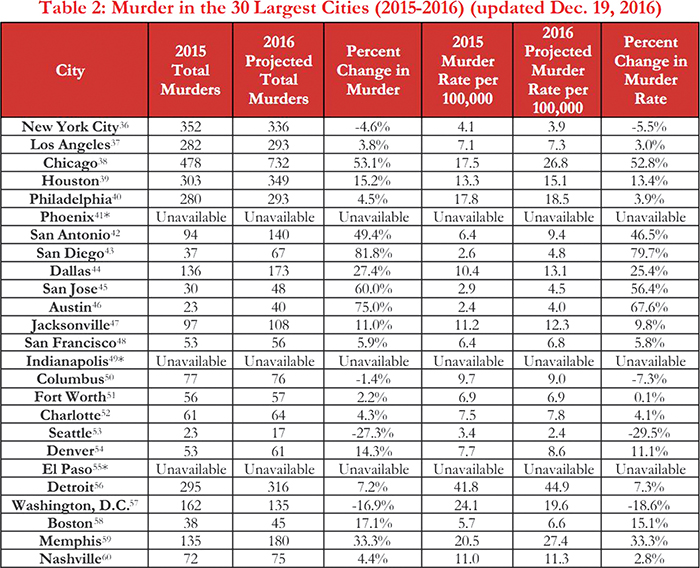Courtesy of the Brennan Center for Justice at NYU School of Law
Murder statistics are one reason why the de Blasio administration has hailed NYC as the safest big city in the country.
By Forum Staff
The overall crime rate in the 30 largest U.S. cities in 2016 is projected to remain roughly the same as in 2015, rising by 0.3 percent; and if this trend holds, crime rates will remain near historic lows, driven by low amounts of property crime, according to “Crime in 2016: an Updated Analysis,” released last week by the Brennan Center for Justice at New York University School of Law.
In September, the Brennan Center analyzed available crime data from the 30 largest cities, projecting that by the end of 2016, these cities would see a nearly unchanged rate of overall crime and a slight uptick in the murder rate. “Crime in 2016: a Preliminary Analysis” concluded that while concerns about “out of control” crime rates were premature, the data “call attention to specific cities, especially Chicago, and an urgent need to address violence there.”
The Dec. 20 edition updates the fall findings, incorporating more recent data, according to report authors Matthew Friedman, Ames Grawert, and James Cullen.
Conclusions include:
- The violent crime rate is projected to increase slightly, by 3.3 percent, driven by increases in Chicago (17.7 percent increase) and Charlotte (13.4 percent increase). This is less than the 5.5 percent increase initially projected in the September report. Violent crime still remains near the bottom of the nation’s 30-year downward trend.
- The 2016 murder rate is projected to be 14 percent higher than last year in the 30 largest cities. Chicago is projected to account for 43.7 percent of the total increase in murders. The preliminary 2016 report identified some reasons for increasing violence in Chicago, such as falling police numbers, poverty, and other forms of socioeconomic disadvantage, and gang violence. A similar phenomenon occurred in 2015, when a group of three cities — Baltimore, Chicago, and Washington, D.C. — accounted for more than half of the increase in murders. This year Baltimore and Washington, D.C., are projected to see their murder rates decline, by 6 percent and 18.6 percent, respectively.
- An increase in the murder rate is occurring in some cities even while other forms of crime remain relatively low. Concerns about a national crime wave are still premature, according to Brennan Center analysts, but these trends suggest a need to understand how and why murder is increasing in some cities.
The Brennan Center update was made available a week after the Federal Bureau of Investigation released details on more than 5.6 million criminal offenses reported by law enforcement to the National Incident-Based Reporting System in 2015. This latest Uniform Crime Reporting program’s report, “National Incident-Based Reporting System 2015,” offers information about victims, known offenders, and relationships between the two for 23 categories comprised of 49 offenses, according to the FBI.
Some highlights from the new NIBRS report:
- NIBRS agencies reported 4,902,177 incidents that involved 5,668,103 offenses, 5,979,330 victims, and 4,607,928 known offenders.
- Of the report offenses, 63 percent involved crimes against property, 23 percent involves crimes against persons, and 14 percent included crimes against society (i.e. gambling and prostitution).
- Of the 4,158,264 individual victims, 23.8 percent were between 21 and 30 years of age; a little more than half (51 percent) were female; and the majority of victims (72 percent) were white, while the next largest percent (20.8) were black or African-American.
- Of the known offenders, more than 44 percent were between the ages of 16 and 30, and most offenders (63.3 percent) were male.

